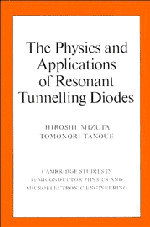Book contents
- Frontmatter
- Contents
- Preface
- 1 Introduction
- 2 Introduction to resonant tunnelling in semiconductor heterostructures
- 3 Scattering-assisted resonant tunnelling
- 4 Femtosecond dynamics and non-equilibrium distribution of electrons in resonant tunnelling diodes
- 5 High-speed and functional applications of resonant tunnelling diodes
- 6 Resonant tunnelling in low-dimensional double-barrier heterostructures
- Index
5 - High-speed and functional applications of resonant tunnelling diodes
Published online by Cambridge University Press: 26 January 2010
- Frontmatter
- Contents
- Preface
- 1 Introduction
- 2 Introduction to resonant tunnelling in semiconductor heterostructures
- 3 Scattering-assisted resonant tunnelling
- 4 Femtosecond dynamics and non-equilibrium distribution of electrons in resonant tunnelling diodes
- 5 High-speed and functional applications of resonant tunnelling diodes
- 6 Resonant tunnelling in low-dimensional double-barrier heterostructures
- Index
Summary
In contrast to the preceding chapters, which concentrated mainly on the physics of RTDs, this chapter reviews some applications of RTDs and related three-terminal devices. As briefly described in the first chapter, RTDs have two distinct features over other semiconductor devices from an applications point of view: namely, their potential for very-high-speed operation and their negative differential conductance. The former feature arises from the very small size of the resonant tunnelling structure along the direction of carrier transport; because of the short distance through which carriers must travel, RTDs can be designed to have very high cut-off frequencies. As a result, oscillation in submillimetre wave frequencies has been reported. Besides this highspeed potential, the negative differential conductance makes it possible to operate RTDs as so-called functional devices, which enables circuits to be designed on different principles than conventional devices. For example, signal processing circuits with a significantly reduced number of devices and multiple-valued memory cells using RTDs have been proposed and demonstrated. These functional applications are highly promising since RTDs, with their simple structure and small size, can be easily integrated with conventional devices such as field effect transistors (FETs) and bipolar transistors.
In Section 5.1, high-speed applications, including high-frequency signal generation and high-speed switching, are discussed. Functional applications, such as a one-transistor static random access memory (SRAM) and a multi-valued memory circuit, are described in Section 5.2.
- Type
- Chapter
- Information
- The Physics and Applications of Resonant Tunnelling Diodes , pp. 133 - 177Publisher: Cambridge University PressPrint publication year: 1995
- 3
- Cited by



